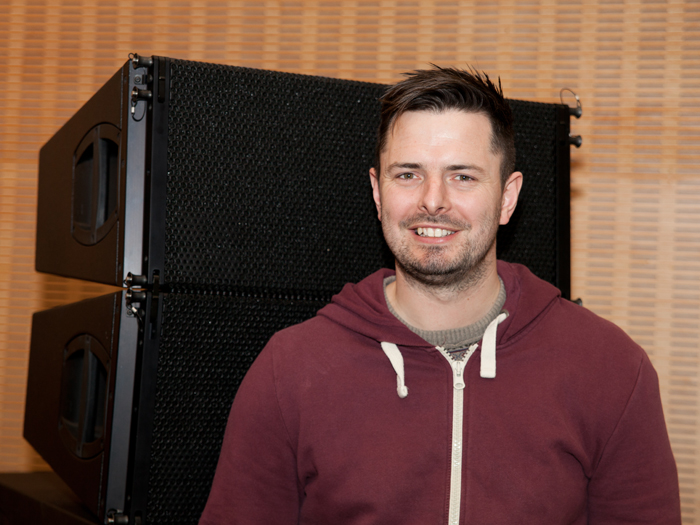Steve Jones’ glittering career behind a drumkit was interrupted to mix FoH for friends’ bands, before deciding to pursue a more ‘sensible’ audio profession. A degree in Live Performance Technology from Derby University led directly to the hire and events department at TMC in Bradford, before a role in the Education and Application Support team for d&b audiotechnik in the UK. Nine years later and Steve heads up the department and an ever-growing team of technical specialists. The Acoustic Explorer, as he’s affectionately known, spends his days helping design and use sound systems to their potential, or presenting as part of the company’s international education and training program, including the fifteen year old Electroacoustics seminar, now something of an industry standard.
I would argue the Electroacoustics seminar is the most important thing d&b does in terms of its education and training programme – it goes back to the absolute basics to explain how loudspeakers interact with their environment and how that affects what the listener hears.
We know some sound engineers out there go about their work, and whether out of repetition or experience they understand a certain action gets a certain result, but sometimes without fully understanding why. That’s why getting to grips with the principles of electroacoustics is so important, because it explains the underlying mechanics of what’s going on in any scenario. In terms of sound system design and engineering these are our building blocks, for quite literally everything we do – without them nothing else makes much sense.
The good news is that physics is pretty reliable, so the fundamentals for good sound system design are the same whether you have a single speaker within four walls or an outdoor audience of 100,000. What can and does change is the available technology – so it’s about understanding what’s going on with the physics, the constants if you like, and using that knowledge to select the right system for the right application. If we think about how all this relates to festivals, or other large scale open air scenarios, we can see a number of electroacoustic principles behind trends in technology, such as the shift from using point source clusters to line arrays.
Addition and subtraction of sound waves
When you put two sound sources in two different places and point them roughly in the same direction, their coverage is going to overlap, and because they’re positioned in slightly different places that coverage will arrive at different times. The result is that some frequencies add, and some cancel each other out. We call this effect comb filtering. Christian Heil of L-Acoustics introduction of large scale line arrays with wave guides made it possible to eliminate comb filtering to a significant extent. This meant a much more coherent wave front emanating from all of the speakers within the array, and coherent noise out of all different frequencies.
System sizing
Our ability to control where we put sound is very much linked to the size of a speaker and so the physically bigger we make the sound source the better we can control its directivity to a lower and lower frequency. So the line array also gives us the ability to control sound down to a very low frequency as we are essentially creating one big loudspeaker from multiple smaller elements.
Inverse square law
Take a point source on its own – the level drop is a 6dB loss for every doubling of distance, so from 10m to 20m you lose
6dB, from 100m to 200m you lose 6dB, and so on (excluding atmospheric effects), whereas with a line array, we have the ability to achieve more like a 3dB level drop in certain circumstances. The way I try to demystify this is to say that every individual speaker drops by 6dB from a line array but as you double the distance back from a line array, you can introduce 3dB more loudspeakers into your listening experience, so what you actually perceive is a 3dB level drop. And that means we can make the sound much more even over our audience area, which helps us give everyone a much more consistent listening level – something that’s key to the collective crowd experience.
Everyday electroacoustics
Once we start thinking about how the principles of electroacoustics inform the technology we use and how we use it, whether it’s in terms of how we space drivers close together in a line array to eliminate comb filtering, or how physical size gives us control to lower and lower frequencies – we can take those same principles and apply them elsewhere. For example at d&b we are big fans of using subwoofer arrays because a sub array is pretty much exactly the same as a line array in the air. We’re effectively just applying the principle of creating one very big loudspeaker from smaller loudspeakers, to give us pattern control to a very low frequency; we then shape the resulting dispersion pattern with different delay times on the individual subs.
One of the most challenging issues for sound designers at open air events is assessing far field noise immissions, and this is in part because the environmental modelling software has only ever been able to account for point source behaviour. Another limitation of the available software has been its inability to model complex systems comprising mains, fill, subs, and their interaction with each other. And it’s understanding this interaction of the individual component’s phase, level and directivity, that leads to the full system’s overall directivity performance.
Festivals are close to the heart of d&b and so there was a real drive to address the shortcomings in the available modelling software. The result is d&b NoizCalc, a new tool for modelling noise immissions, developed in collaboration with noise consulting and software development company SoundPLAN. With NoizCalc we’re now able to take all these very complex electroacoustic behaviours of sound sources and model how a system’s various parts truly work together. The software also allows us to take into account air absorption, ground effect, buildings, even weather to an extent – though no one can predict that exactly! And then we can apply ISO, and NORD standards to the predicted propagation of sound and actually be able to produce an assessment that is true against all the criteria we can currently model. Ultimately what NoizCalc represents is a bridging of the language, or skill set between the system tech’s and the people looking after environmental noise, whether that’s the local council or an acoustic consultancy.
Sound people are a passionate lot and we’re naturally drawn to new developments in our industry. NoizCalc will undoubtedly mean better communication between the teams involved in open air events, and optimum sonic results for everyone through a more informed decision making process – with not just the partygoers in mind but the people who live in the surrounding area. But in the end, as a system engineer, cutting edge developments will never be as beneficial to you, or as much fun to use, unless you get behind the basics first.

